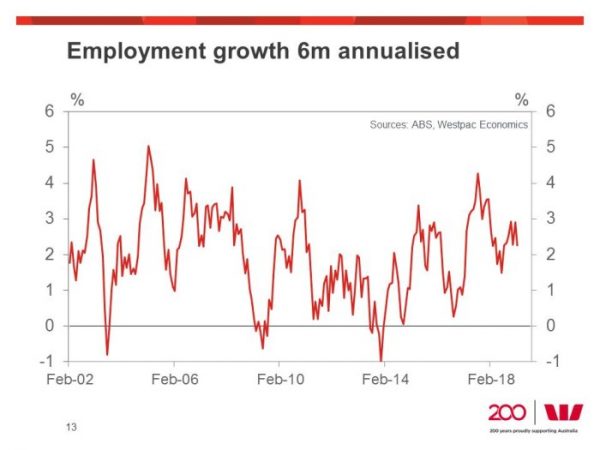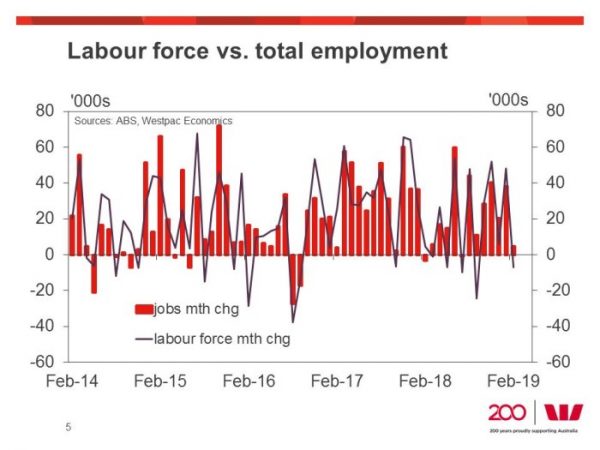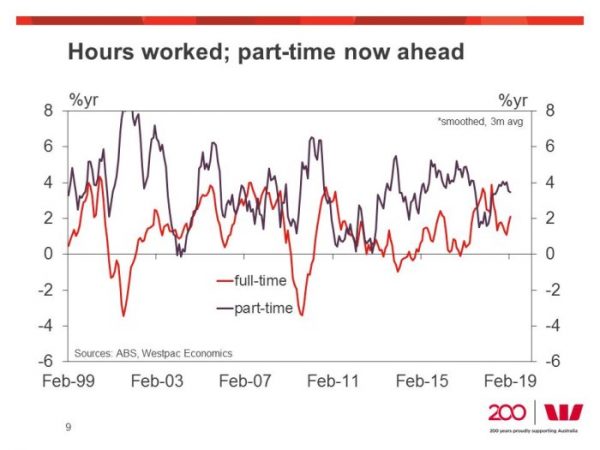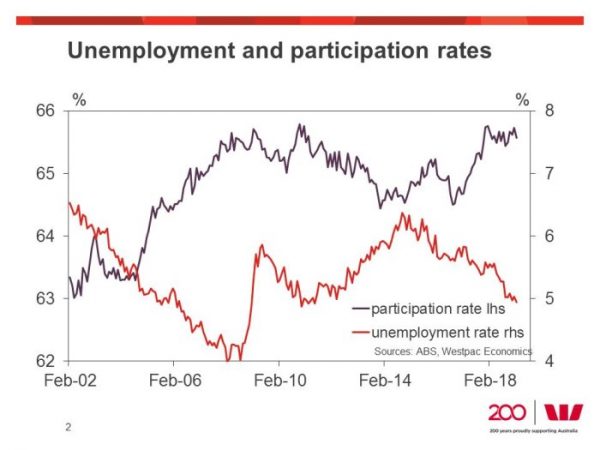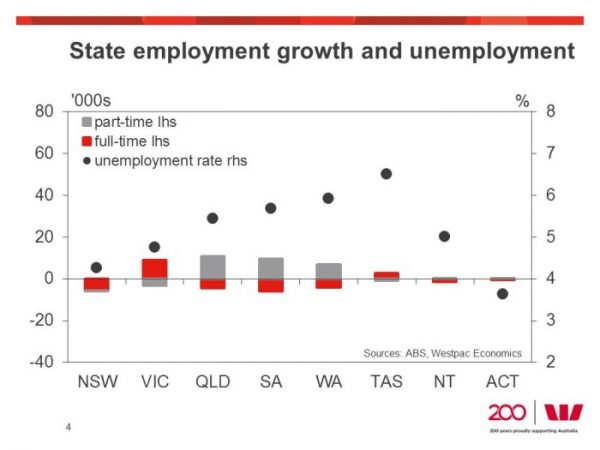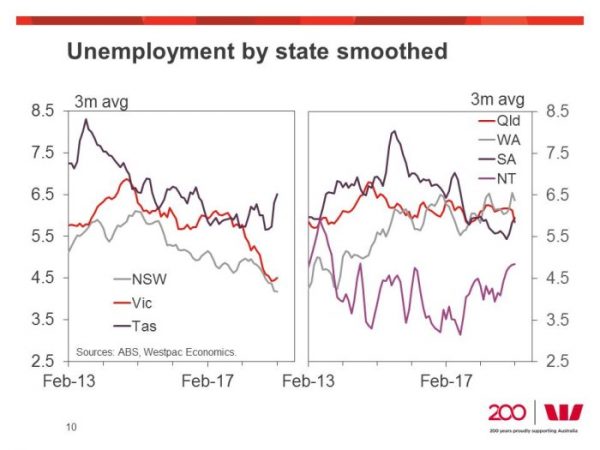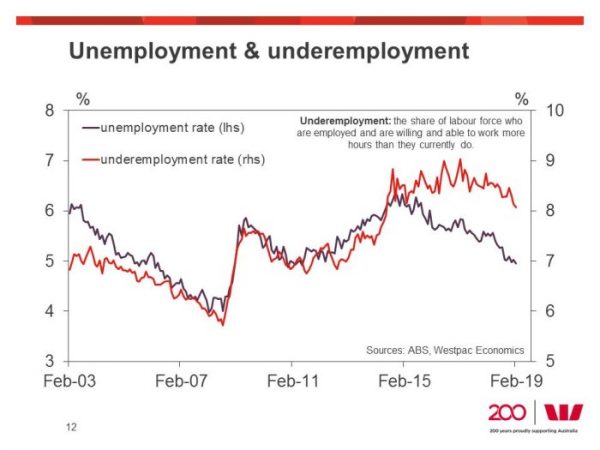February Labour Force Survey: Total employment: 4.6k from 38.3k (revised from 39.1k), unemployment rate: 4.9% from 5.0% (unrevised 5.0%), participation rate: 65.6% from 65.7% (unrevised 65.7%).
Employment growth slowed in February lifting 4.6k less than what the market was looking for (median +15k) but a touch better than Westpac’s forecast of –5k. So far 2019 has had a sound start for the labour market with a three month average gain of 21.1k/per month. Through 2018 total employment grew 274.5k, or 2.2%yr, with a solid momentum into year end with a six month annualised pace of 2.3%yr. While it is just second month into the year, employment grew 284k in the year to February (2.3%yr) but the six month annualised pace has moderated from 2.9%yr in January to 2.3%yr in February.
As highlighted in our preview we are very cautious about making too much of the January/February releases given the large underlying seasonality in these months. However, what we can say is that it does appear that the momentum in employment has slowed. As such, there is nothing in this release to make us change our view that employment growth will take a breather through the first half of 2019 leading to a lift in unemployment. But, to be fair, the fall in the unemployment rate to 4.9% also means that at this point in time, the RBA will also feel little pressure to change their forecast for the unemployment rate to fall to 4¾%. It will all come down to who is the better forecaster.
In February, in reverse to the January result, the mix of employment gains painted a soft picture with a 7.3k loss in full-time employment offset by an 11.9k gain in part-time employment. However, hours worked was a bit more upbeat in the month with total hours worked up 0.2% (total employment was flat in the month) as hours worked per person gained 0.1% due to average hours worked rising for both full-time and part-time employees. In the year to February total hours worked has lifted 2.2%yr which is on par with the 2.3%yr pace for employment.
Despite the soft print on employment, the unemployment rate fell to 4.9% (market median was 5.0%) as a 0.1ppt decline in the participation rate to 65.6% (65.57% at two decimal places) resulted in a –7.1k decline in the labour force. At this stage it appears that both male and female participation is levelling out in a trend sense and we are closely watching where they go next. We do expect both to edge lower though 2019 H1 as employment growth stalls.
February was a soft month for employment growth across the states. Employment fell 5.8k in NSW (+128.9k in the year) and the unemployment rate lifted to 4.3% from 3.9% which was a 30 year low in unemployment for that state. In Victoria, employment lifted 5.7k (+136.7k in the year) but with a lift in participation, the unemployment rate lifted to 4.8% from 4.6%. Queensland employment lifted in February 6.4k (+20.4k in the year) but a decline in participation saw the unemployment rate dip to 5.4% from 6.1%. In WA employment rose 2.8k (+7.7k in the year) with the 1ppt fall in unemployment to 5.9% being supported by a 0.6ppt fall in participation. Meanwhile in SA a lift in employment 3.8k (–0.1k in the year) in February saw the unemployment rate ease back 0.6ppt to 5.7%.
Overall, while the annual pace of employment growth has picked up in Victoria, and eased back in NSW, NSW can still claim the mantle of having the lowest unemployment rate.
Victoria was the state showing the greatest improvement through 2018 with the unemployment rate down 2ppts to 4.2% in December while in NSW unemployment fell just 0.5ppts to 4.3%.
We are closely watching how these trends continue through 2019 – NSW did surprise in January by dipping below 4%, but it has since bounced back to 4.3%, while Victoria’s improvement does look to be cooling with the unemployment rate holding above 4.5%. It is these two states, and how their labour markets will respond to falling house prices, a contraction in construction activity and weak retail sales, that is behind our expectation for the unemployment rate to rise through the first half of this year. While we are cautious about interpreting too much from the January/February releases, we see nothing in them that makes us nervous about our forecasts.
It is also worth noting that in 2018, for all the strength in the labour market, the underemployment rate only declined 0.2ppt. So far there has been a further improvement with the rate falling from 8.3% in December to 8.1% in February. Again, we would caution that so far we have only see the January and February prints, so would not project that this improvement can be sustained, but nevertheless, it is another indicator of just how robust the labour market was at the end of 2018.
For 2019, we are looking for a pause in the pace in employment growth due to the economic uncertainties surrounding the Federal Election at the same time as we expect to see a moderation in momentum in NSW and Victoria on the back of a moderation in housing activity. With reasonable estimates for the participation rate, our weaker jobs growth profile has the unemployment rate lifting to 5.5% in the second half of 2019 and further by end 2020.




